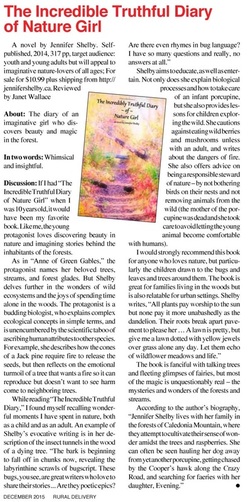
A novel by Jennifer Shelby. Self-published. 2014. 317 pp. Target audience: youth and young adults but will appeal to imaginative nature-lovers of all ages. For sale for $10.99 + shipping from http://jennifershelby.ca
Reviewed by Janet Wallace
About: The diary of an imaginative girl who discovers beauty and magic in the forest.
In two words: Whimsical & insightful.
Discussion: If I had The Incredibly Truthful Diary of Nature Girl when I was ten years old, it would have been my favourite book. Like me, the young protagonist loves discovering beauty in nature and imagining stories behind the inhabitants of the forests.
As in Anne of Green Gables, the protagonist names her beloved trees, streams and forest glades. But Shelby delves further in the wonders of wild ecosystems and the joys of spending time alone in the woods. The protagonist is a budding biologist, who explains complex ecological concepts in simple terms, and is unencumbered by the scientific taboo of ascribing human attributes to other species. For example, she describes how the cones of a Jack Pine require fire to release the seeds, but then reflects on the emotional turmoil of a tree that wants a fire so it can reproduce but doesn’t want to see harm come to neighbouring trees.
While reading The Incredibly Truthful Diary, I found myself recalling wonderful moments I have spent in nature, both as a child and as an adult. An example of Shelby’s evocative writing is in her description of the insect tunnels in the wood of a dying tree.
“The bark is beginning to fall off in chunks now, revealing the labyrinthine scrawls of bugscript. These bugs, you see, are great writers who love to share their stories... Are they poetic epics? Are there even rhymes in bug language? I have so many questions and really, no answers at all.”
Shelby aims to educate, as well as entertain. Not only does she explain biological processes and how to take care of an infant porcupine, but she also provides lessons for children exploring the wild. She cautions against eating wild berries and mushrooms unless with an adult and writes about the dangers of fire. She also offers advice on being a responsible steward of nature – by not bothering birds on their nests and not removing animals from the wild (the mother of the porcupine was dead and she took care to avoid letting the young animal become comfortable with humans).
I would strongly recommend this book for anyone who loves nature, but particularly the children drawn to the bugs and leaves and trees around them. The book is great for families leaving in the woods but also works for urban settings. Shelby writes, “All plants pay worship to the sun but none pay it more unabashedly as the dandelion. Their roots break apart pavement to please her… A lawn is pretty, but give me a lawn dotted with yellow jewels over grass alone any day. Let them echo of wildflower meadows and life.”
The book is fanciful with talking trees and fleeting glimpses of fairies, but most of the magic is unquestionably real – the mysteries and wonders of the forests and streams.
According to the author’s biography, “Jennifer Shelby lives with her family in the forests of Caledonia Mountain, where they attempt to cultivate their sense of wonder amidst the trees and raspberries. She can often be seen hauling her dog away from yet another porcupine, getting chased by the cooper’s hawk along the Crazy Road, and searching for faeries with her daughter, Evening.”
 RSS Feed
RSS Feed